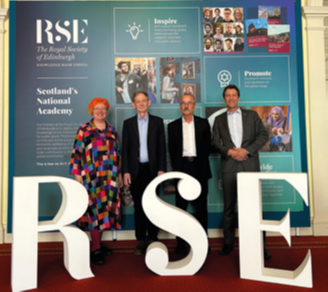Dr Brent Clothier FRSNZ and Paul Atkins visit the Royal Society of Edinburgh

By Dr Brent Clothier and Paul Atkins
Connections are critical in an ever-complex world. International, inter-academy, and inter-disciplinary linkages are all vital if we are to play an effective role in informing and enabling great solutions to significant global challenges.
Our recent visit to the RSE reinforced this and we are grateful to all involved for the warm hospitality and energising conversations. We wholeheartedly support the mission of 'knowledge made useful'!
Despite being at the opposite ends of the earth, the RSE and Royal Society Te Apārangi enjoy strong links dating back to Society’s foundation. In February 1862, the RSE elected the Scottish medical doctor, explorer, and geologist James Hector. Just two months later, albeit after a journey of 102 days, Hector landed in New Zealand and in 1867 formed the New Zealand Institute. In 1933, it changed its name to the Royal Society of New Zealand, and in 2007 we were given the Māori name, Te Apārangi, meaning a group of experts.
Today, the Society and the RSE continue to enjoy a close interpersonal relationship. But that is not the only important similarity and connection – we share the characteristic of having academies that embrace not just science, but also social science, the arts and humanities. Our ability to draw people together from across the different disciplines from within our own ‘family’ is an extraordinary strength as we seek to bring effect to true transdisciplinarity.
Following six months of broad consultation with our members and stakeholders, the Society is in the process of developing our strategic plan for the next twenty years. It is the first time our Society has looked forward this far. It recognises the need to be internationally intergenerational and look to the potential for long-term impact of our work as well as the shorter-term goals to be found in our annual business planning. Discussions with RSE colleagues regarding the development of the RSE’s strategic plan 2023–2028 have been extremely valuable. The next five years will be crucial to our respective nations and how we make knowledge useful our critical contribution.
Another topic of discussion, and of great benefit to us, was the origins, structure and functioning of the Young Academy of Scotland (YAS). The reports and publications coming out of the YAS are impressive. Although the Society does not have a young academy in the same form, we do have under our auspices an active Early Career Researchers’ Forum, with a representative who sits ex officio on the Council of the Society. As the international connectivity of the young academies grows, we will seek to support our early career researchers in that network.
There were other topics of mutual benefit discussed during our visit – approaches to ensuring equity, diversity and inclusivity in our academies, and the processes we use to appoint a President-Elect.
We look forward to building on this brief catch-up to initiate longer-term connections between our two like-minded Societies and honour the legacy of Sir James Hector.
Source: ReSourcE Summer 2023
